Horniman Museum
The Horniman Museum and Gardens is a museum in Forest Hill, London, England. Commissioned in 1898, it opened in 1901 and was designed by Charles Harrison Townsend in the Arts and Crafts style.[2] It has displays of anthropology, natural history and musical instruments, and is known for its large collection of taxidermied animals.
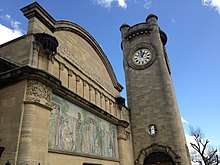 | |
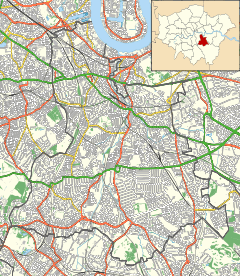 Location within London Borough of Lewisham | |
| Established | 1901 |
|---|---|
| Location | Forest Hill London, SE23 United Kingdom |
| Visitors | 926,849 (2018)[1] |
| Public transit access | |
| Website | horniman.ac.uk |
It is a non-departmental public body of the Department for Digital, Culture, Media and Sport and is constituted as a company and registered charity under English law.[3]
History
The museum was founded in 1901 by Frederick John Horniman. Frederick had inherited his father's Horniman's Tea business, which by 1891 had become the world's biggest tea trading business.[4]
The cash from the business allowed Horniman to indulge his lifelong passion for collecting, and which after travelling extensively had some 30,000 items in his various collections, covering natural history, cultural artefacts and musical instruments.
In 1911, an additional building to the west of the main building, originally containing a lecture hall and library, was donated by Frederick Horniman's son Emslie Horniman. This was also designed by Townsend. A new extension, opened in 2002, was designed by Allies and Morrison.[5]
Collections
The Horniman specialises in anthropology, natural history and musical instruments[6] and has a collection of 350,000 objects. The ethnography and music collections have Designated status. One of its most famous exhibits is the large collection of stuffed animals. It also has an aquarium noted for its unique layout.
Floor directory
| 1st Floor | Ground Floor | Lower Ground Floor | Basement Floor |
|---|---|---|---|
| Under 5s Book Zone Natural History Balcony Horniman Highlight Objects 3 Apostle Clock, England |
Main Entrance CUE Building Conservatory Café Shop Education Centre Hands On Base Natural History Gallery Balcony Gallery Environment Room Horniman Highlight Objects 1 Sand Painting, America 2 Walrus, Canada |
World Gallery
Temporary Exhibition Gallery Horniman Highlight Objects |
Aquarium |
Transport connections
| Service | Station/Stop | Lines/Routes served | Distance from Horniman Museum |
|---|---|---|---|
| London Buses |
Horniman Museum | 176, 185, 197, 356, P4 | |
| Horniman Park | 363 | 260 m (850 ft) walk[7] | |
| London Overground |
Forest Hill | East London line | 650 m (2,130 ft) walk[8] |
| National Rail | Southern |
Gardens

The museum is set in 16 acres (65,000 m2) of gardens, which include the following features:
- A Grade II listed conservatory from 1894 which was moved from Hornimans' family house in Croydon to the present site in the 1980s.
- A bandstand from 1912
- An enclosure for small animals
- A Butterfly House
- A nature trail
- An ornamental garden
- Plants for materials, medicines, and foods and dyes
- A sound garden with large musical instruments for playing
- A new building, the Pavilion, for working on materials that are outside of the collections, such as from the gardens.
The gardens are also Grade II listed on the Register of Historic Parks and Gardens of Special Historic Interest in England.[9]
Mosaic

On the London Road wall of the main building is a neoclassical mosaic mural entitled Humanity in the House of Circumstance, designed by Robert Anning Bell and assembled by a group of young women over the course of 210 days. Composed of more than 117,000 individual tesserae, it measures 10 ft × 32 ft (3.0 m × 9.8 m) and symbolises personal aspirations and limitations.[10]
The three figures on the far left represent Art, Poetry and Music, standing by a doorway symbolising birth, while the armed figure represents Endurance. The two kneeling figures represent Love and Hope, while the central figure symbolises Humanity. Charity stands to the right bearing figs and wine, followed by white-haired Wisdom holding a staff, and a seated figure representing Meditation. Finally, a figure symbolising Resignation stands by the right-hand doorway, which represents death.[11]
Totem pole

A 20 ft (6.1 m) totem pole, carved from red cedar, stands outside the museum's main entrance. It was carved in 1985 as part of the American Arts Festival by Nathan Jackson, a Tlingit native Alaskan. The carvings on the pole depict figures from Alaskan legend of a girl who married a bear, with an eagle (Jackson's clan crest) at the top.[12] The pole is one of only a handful of totem poles in the United Kingdom, others being on display at the British Museum, the National Museum of Scotland in Edinburgh, Windsor Great Park, Bushy Park, the Yorkshire Sculpture Park, the Pitt Rivers Museum at Oxford, and at Alsford's Wharf in Berkhamsted.[13] There is also a totem pole in the Royal Albert Memorial Museum in Exeter. It is displayed in their World Cultures galleries.
CUE building
The Horniman Museum contains the CUE (Centre for Understanding the Environment) building. This opened in 1996 and was designed by local architects Archetype using methods developed by Walter Segal. The building has a grass roof and was constructed from sustainable materials. It also incorporates passive ventilation.
Gallery
 Museum main gallery
Museum main gallery The CUE Building
The CUE Building The exterior of the conservatory
The exterior of the conservatory The interior of the conservatory
The interior of the conservatory The bandstand from 1912
The bandstand from 1912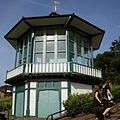 The bandstand viewed from below in July 2013
The bandstand viewed from below in July 2013 The Horniman totem pole
The Horniman totem pole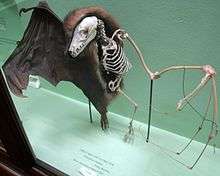 A preserved fruit bat showing how the skeleton fits inside its skin.
A preserved fruit bat showing how the skeleton fits inside its skin.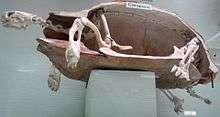 A preserved turtle skeleton showing how the carapace connects with the rest of the skeleton.
A preserved turtle skeleton showing how the carapace connects with the rest of the skeleton. Canadian walrus
Canadian walrus The Natural History Gallery with the overstuffed walrus replaced with a giraffe model in July 2013
The Natural History Gallery with the overstuffed walrus replaced with a giraffe model in July 2013
See also
References
- "ALVA - Association of Leading Visitor Attractions". www.alva.org.uk. Retrieved 27 July 2019.
- Horniman Museum and Gardens accessed 02/01/08
- Charity Commission. Horniman Public Museum and Public Park Trust, registered charity no. 802725.
- "Horniman Public Museum and Public Park Trust - GOV.UK". www.gov.uk.
- https://www.architecture.com/FindAnArchitect/ArchitectPractices/AlliesandMorrisonArchitects/Projects/HornimanMuseum-94502.aspx
- "Horniman Museum". Time Out London.
- "Walking directions to '''Horniman Museum''' from '''Horniman Park''' bus stop". Maps.google.co.uk. Retrieved 25 June 2013.
- "Walking directions to '''Horniman Museum''' from '''Forest Hill''' railway station". Maps.google.co.uk. Retrieved 25 June 2013.
- Historic England, "Horniman Gardens (1000813)", National Heritage List for England, retrieved 27 May 2017
- "FAQs – Horniman Museum". Saatchi Gallery. Retrieved 24 March 2013.
- Jacqueline Banerjee. "The Horniman Museum by Charles Harrison Townsend". The Victorian Web. Retrieved 24 March 2013.
- "Main entrance". Horniman Museum. Archived from the original on 16 July 2011. Retrieved 18 August 2010.
- Tearle, John (1998). The Berkhamsted Totem Pole. Lillydown House. ISBN 978-0-9528131-1-8. p.3
External links
| Wikimedia Commons has media related to Horniman Museum. |